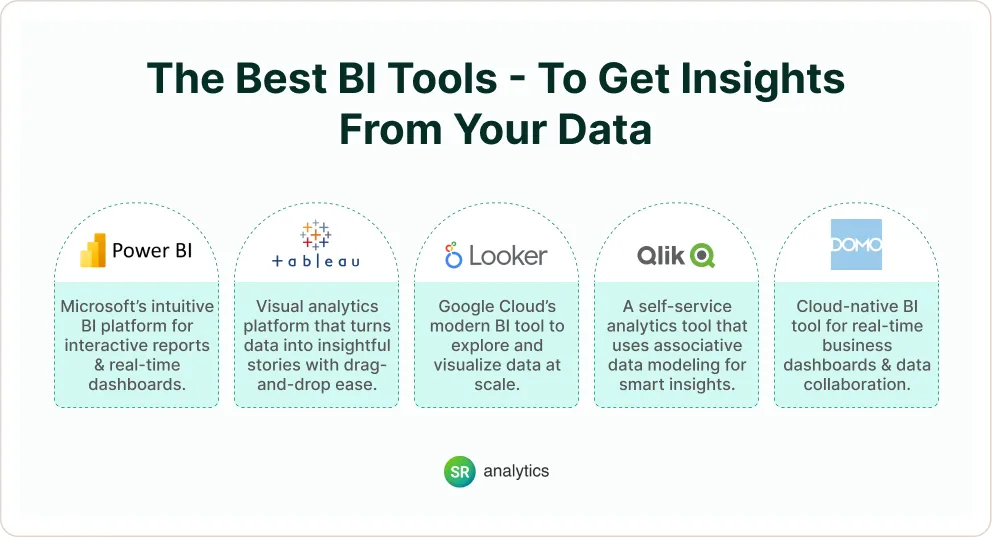In today’s fast-paced business world, companies lean on Business Intelligence (BI) to turn messy data into smart decisions. It’s like having a roadmap for growth showing you where to go and how to get there. But even with all its promise, BI isn’t foolproof.
Things like shaky data or teams pushing back against new tech can throw a wrench in the works. Let’s dive into these everyday business intelligence challenges and unpack simple, no-nonsense ways to fix them so your team can work sharper and faster.
Ready to see how modern business intelligence services can clear the path and open new doors? Let’s go.

Why Business Intelligence Is a Game-Changer
BI isn’t just a buzzword, it’s a powerhouse. It digs into your data to spot trends, streamline how you operate, and pump up your profits. But here’s the catch: glitches like sloppy data or systems that don’t talk to each other can trip you up.
Our mission? To hand you practical, step-by-step solutions to dodge these traps. Whether you’re deep into BI tools or just dipping your toes into AI-powered insights, this guide’s got your back.
Top 9 Business Intelligence Challenges to Consider
1. Poor Data Quality: The Hidden Threat to BI
Nothing stings worse than data you can’t trust. Think duplicates clogging your system, entries that contradict each other, or gaps where info should be it’s a mess. When your reports are built on shaky ground, you’re left second-guessing every move.
Worse, it can lead to pricey slip-ups that waste time and cash. If the numbers aren’t solid, even the sharpest business call can flop.
Causes of Data Quality Issues
- Duplicate records from manual entry.
- Inconsistent formats across systems.
- Missing or outdated information.
Business Impact
Poor data quality costs time and money. It erodes confidence in BI intelligence. Teams waste hours fixing errors instead of analyzing insights.
Solutions for Data Quality Issues
- Establish data governance policies. Set clear rules for data entry and maintenance.
- Conduct regular audits and cleansing. Use automated tools to spot and fix errors.
- Leverage data profiling tools. These validate data accuracy and consistency.
By prioritizing data quality issues and solutions, you build a solid foundation for business intelligence systems.
Read more about Establishing Strong Data Governance
Case Studies: AI models corrupted by Unity’s audience data
Unity Technologies, which specializes in a real-time 3D content platform, experienced a data quality incident in Q1 2022. First, the inaccuracies in its Pinpointer tool led to the erroneous ingest of data from a large customer, which resulted in $110 million loss in revenue. Unity’s stock fell 37%. Its CEO Ricicitello promised investors a return to better-quality data.
2. Disconnected Data Sources: Breaking Down Silos
Data often lives in separate systems CRM, ERP, or marketing platforms. This creates silos. Fragmented data leads to incomplete insights, slowing decision-making.
Challenges of Data Integration
- Systems don’t “talk” to each other.
- Manual data exports waste time.
- Inconsistent data formats cause errors.
Consequences
Siloed data limits visibility. Teams miss critical trends. This hurts strategic planning and agility.
Data Integration Solutions
- Create a unified data lake or warehouse. Centralize data for easy access.
- Implement ETL processes. Extract, transform, and load data seamlessly.
- Use APIs and middleware. These connect systems for smooth data flow.
With data integration solutions, your BI system delivers unified, reliable insights.
3. Low BI Tool Adoption: Getting Users Onboard
Even the best BI tools fail if users don’t embrace them. Complexity, poor design, or lack of training often cause resistance.
Why Users Resist
- Dashboards feel overwhelming.
- Tools lack intuitive interfaces.
- Employees don’t understand benefits.
Signs of Low Adoption
- Minimal logins or usage.
- Teams revert to spreadsheets.
- Complaints about complexity.
Solutions to Boost Adoption
- Offer end-user training . Teach teams how to use business intelligence tools effectively.
- Design intuitive dashboards . Focus on user-friendly UI/UX.
- Involve stakeholders early . Let users help choose tools to ensure buy-in.
By focusing on user success, you maximize the value of business intelligence solutions .
4. Performance and Scalability Issues: Speeding Up Insights
Slow dashboards and lagging queries frustrate users. These issues often stem from outdated systems or inefficient setups.
Symptoms
- Dashboards take forever to load.
- Reports delay critical decisions.
- Systems crash under heavy use.
Root Causes
- Unoptimized data models.
- Legacy infrastructure struggles with volume.
- Poorly written queries hog resources.
Solutions for Better Performance
- Optimize data models and indexing . Streamline how data is stored and accessed.
- Adopt cloud BI platforms . These scale effortlessly with demand.
- Use query optimization techniques . Write efficient code to speed up results.
A high-performing BI system keeps your team moving fast.
For example, One of the leading telecom companies had challenges handling query response times that increased from 2 seconds to over 2 minutes for billions of rows of data.
The real problem was that their system was storing over 50 million rows every day straining the memory and allowing the CPU utilization to scale above 90% As a consequence, infrastructure costs grew by 30%, which made it harder for users to access real-time insights and delayed decision making.
Source: Kyvos Insights Case Study

5. Security and Compliance Risks: Protecting Your Data
Sensitive data attracts cyberattacks. Rules like GDPR and HIPAA raise the stakes. If businesses don’t protect their BI tools, they risk heavy fines and lost customer trust.
Proactive security keeps data safe and avoids costly setbacks.
Challenges
- Unauthorized access to data.
- Compliance with evolving laws.
- Protecting data across platforms.
Solutions
- Implement role-based access control (RBAC). Limit who sees sensitive data.
- Encrypt data at rest and in transit. This ensures end-to-end security.
- Conduct regular security audits. Track compliance and fix vulnerabilities.
With strong BI services, you safeguard data and stay compliant.
6. Lack of Clear BI Strategy: Aligning Tools with Goals
Using BI tools without a strategy is like sailing without a map. You might move, but you won’t reach your destination.
The Problem
- Tools are deployed without clear KPIs.
- Teams don’t know what success looks like.
- Investments fail to deliver ROI.
Results
- Wasted budgets on unused features.
- Misaligned priorities.
- No measurable impact.
Solutions for a Strong BI Strategy
- Align BI with business goals. Focus on outcomes like revenue growth or efficiency.
- Define clear success metrics. Track progress with specific KPIs.
- Evaluate BI performance regularly. Adjust as needs evolve.
A clear strategy turns business intelligence services into a growth engine.
Case Study: Lack of Clear BI Strategy and Alignment with Goals
One global manufacturing organization with significant BI tools misalignment faced challenges in achieving Strategic Objectives. When multiple departments began using their own disconnected analytics tools, data silos began to form, leading to challenges in extracting unified insights.
This disconnect resulted in delayed decision-making and inconsistent reporting. This resulted in performance issues: some dashboards took as long as 3–5 minutes to load, turning query response times grew exponentially once the data volumes crossed 1TB, impacting user adoption.
The absence of a clear BI strategy hampered the scalability of their infrastructure, influencing the business agility itself.
Source: BI Case Study by Madan Agrawal
7. Inadequate Real-Time Insights: Keeping Up with Now
Batch processing delays insights. In a fast-moving market, businesses need live data to act quickly.
Issues
- Reports lag behind reality.
- Teams miss critical trends.
- Decision-making slows down.
Demand
- Live dashboards for instant visibility.
- Alerts for real-time updates.
Solutions for Real-Time BI
- Build real-time data pipelines. Stream data as it’s generated.
- Use event-driven analytics. Trigger actions based on live events.
- Adopt streaming data solutions. Handle high-velocity data with ease.
Real-time business analytics keeps you ahead of the curve.
8. Choosing the Wrong BI Tools: Finding the Right Fit

Picking the wrong BI tools wastes time and money. Over-engineered platforms or vendor lock-in can trap businesses.
Common Mistakes
- Choosing tools that don’t match needs.
- Ignoring long-term scalability.
- Overlooking hidden costs.
Why It Matters
The right BI tools align with your team’s skills and goals. A bad fit creates frustration and inefficiency.
Solutions
- Assess requirements first. Know your data, users, and goals.
- Choose scalable, user-friendly tools. Avoid rigid or complex platforms.
- Evaluate total cost of ownership (TCO). Factor in licenses, training, and support.
With careful selection, business intelligence solutions drive lasting value.
Strategic Approaches to Solve Business Intelligence Challenges
Business Intelligence (BI) : BI involves technologies, tools, and processes that organizations use to collect, analyze, and present data to support decision-making. It transforms raw data into actionable insights through data visualization, reporting, and analytics.
Key Strategic Approaches to Solve BI Challenges:

Data Integration and Quality:
- Challenge: Fragmented data sources (silos) and poor data quality lead to inaccurate insights.
- Approach: Implement robust ETL (Extract, Transform, Load) processes and data governance frameworks to ensure clean, consistent data. Use integration platforms to unify disparate systems.
Scalability and Performance:
- Challenge: Slow processing and inability to handle large data volumes hinder real-time analytics.
- Approach: Adopt cloud-based BI solutions for scalability and optimize data warehouses for high performance (e.g., indexing, partitioning).
User Adoption and Accessibility:
- Challenge: Complex BI tools discourage non-technical users, limiting adoption.
- Approach: Deploy intuitive, self-service BI platforms with user-friendly dashboards and training programs to empower all employees.
Data Security and Compliance:
- Challenge: Data breaches and non-compliance with regulations (e.g., GDPR, CCPA) pose risks.
- Approach: Enforce role-based access controls, encryption, and regular audits to secure data and ensure compliance.
Real-Time Analytics:
- Challenge: Delayed insights fail to support fast-paced decision-making.
- Approach: Leverage in-memory analytics and streaming data platforms to enable real-time reporting.
Cost Management:
- Challenge: High costs of BI tools and infrastructure strain budgets.
- Approach: Opt for cost-effective cloud solutions with pay-as-you-go models and prioritize high-ROI use cases.
Turn Your Business Intelligence Challenges into Wins
Business Intelligence (BI) can be a game-changer for any organization, but let’s be real—it comes with its share of headaches. Messy data, lackluster user buy-in, or a strategy that’s all over the place can make things tricky. The good news? These aren’t dead ends—they’re opportunities in disguise.
With the right approach, you can flip these obstacles into strengths. Think seamless data integration to clean up the chaos, hands-on training to get your team excited, and a rock-solid plan to tie it all together. That’s how you turn a struggling BI system into a powerhouse that drives smarter decisions.
Don’t let bumps in the road slow you down. Take a hard look at your BI setup today. If you need a partner to guide you through the process, companies like SR Analytics can help you map out a plan, put it into action, and see real results.
Ready to make your data work smarter, not harder? Let’s do this.














